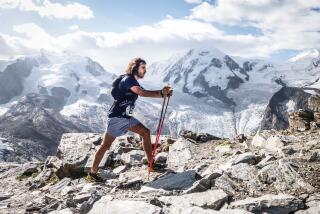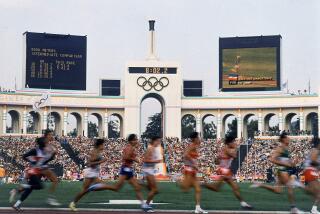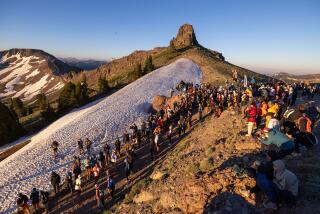Mission Is Found at Mile 14
The biggest problem facing the United States of America today is not the economy, the Persian gulf, Bosnia-Herzegovina, unemployment or even drugs.
It’s kids. Our kids. The enemy is within.
The society has lost faith in itself and its institutions. The nuclear family has fissioned. Authority is not only suspect, it is handcuffed. The American Dream is a hallucination. The melting pot didn’t melt. The voices of unreason shout down the peacemakers.
Nobody knows what to do. Some solve their problems by doing nothing.
Violence is the coin of the realm. Drive-by shootings and mindless territorial gang wars fill the headlines. Children carry machine guns.
There is no one cure for this national unrest. There have to be thousands of them.
But when Harry Shabazian came up with his proposal, most people thought it was the worst idea they had ever heard. Harry didn’t propose to take the kids to the beach or the mountains or a picnic or a songfest. He was offering them, in effect, blood, sweat and tears. The Churchill choice.
His idea was going up to disaffected youngsters and asking innocently, “How would you like to run 26 miles, 385 yards a few times a year and about 10 miles 20 or 30 other times, get tired, sore and out of breath most of the time?”
This was supposed to beat hanging around with the gang, breaking up the dances, cruising the mean streets in a stolen car? Gidoudda here!
But, Harry Shabazian, who had emigrated from Bulgaria, is a liquid-eyed idealist who doesn’t give up easily and has the unsullied view of America’s youth problem only a teacher in the barrio could come across.
Lots of people have thought of putting basketballs or boxing gloves or fielder’s mitts in the hands of problem youngsters. A few have even tried running events--the 100 meters, the hurdles.
But what Harry Shabazian was proposing was mass suffering. A marathon is not a sock hop, a five-second dribble to the basket, a 10-second lope on Tartan, even a fleeting time at bat. What Harry was offering was five hours of excruciating pain that had all the charm of a knife in the lungs, a pain in the rear, a pounding of the limbs, a punishing of the body that could be otherwise produced only by going 20 rounds with Mike Tyson.
The marathon is an event in which even the most proficient go through a curtain of anguish--known as “the wall of pain”--20 miles out.
Harry stumbled on this exquisite form of self-torture in 1986 when he entered the first L.A. Marathon--the seventh is being run today. Harry remembers it had all the appeal of a trip to the electric chair. A marathon is like seasickness--at first, you’re afraid you’re going to die, then you’re afraid you’re going to live.
Harry hit his wall of pain six miles early.
“I sat down at the corner of Rossmore and Santa Monica at Mile No. 14 and said to myself, ‘If I don’t get up and finish this race, I’ll never get in another marathon again,’ ” he says.
“I told myself, ‘You’re crazy. You’re never going to finish this thing. Your legs are cramping, your calves ache, you can’t breathe.’
“But I got up and I crossed the finish line. There’s no feeling like it. You have beaten yourself. Then, I thought I really had to share this with my students. I wanted them to share this emotion.”
Harry’s students were not your basic achievers. He taught social studies and government to a band of misfits, 85% of whom came from single-parent homes and whose only purpose in life seemed to be to get into gangs so they take out their frustrations on society.
A marathon was a hard sell with this group. But Shabazian managed to put together a small track club of five boys and two girls. One kid was such a high-profile tough guy that they figured the only thing he would ever run from would be a murder scene.
Shabazian worked his dirty half-dozen-plus hard. The problem was not so much to beef up their lung capacity and aortic sufficiency as their self-esteem. Harry taught in a school district unit called euphemistically a “continuation” school. Realistically, it was more like a “discontinuation” school. It was the educational equivalent of a last-chance station before entering a trackless waste of a life.
Harry coached his team by joining them.
“I was not one to go out there with a clipboard and stopwatch and yell orders,” he says.
He ran with them. He wasn’t “Coach” or even “Mr.” They called him Harry.
Six of the seven finished the L.A. Marathon that year. One of them, Andrew Duran, a tattooed and mustachioed one-time classroom terrorist, ran the race in 2:45 and, a month later, was to take a razor blade and bottle of rubbing alcohol and scrape the gang tattoos off himself.
“I told him, ‘Some day, people are going to pass judgment on you when they see those tattoos, and you’re not going to like what they conclude,” Shabazian recalls.
Harry’s little band didn’t know it, but their success was to seed a program that not only became progressively bigger but national in scope. The following year, 12 came out and all 12 finished.
And their athletic success moved into academics.
One girl, Carmen Mendoza, who had had a two-pack-a-day cigarette habit and no-show policy toward classes, became the valedictorian of her graduating class. A 320-pound budding dropout, Rene Mendoza (no relation) ended up not only doing the marathon but the equivalent of two years’ academics in a year.
Word of the program reached Roberta Weintraub, a school-board member who promptly got the L.A. Unified School District involved and a city-wide project known as “Students Run L.A.” was formed. More than 250 kids entered the marathon from all over the city in 1990 and 235 finished. In 1991, 450 entered and 426 finished. Last year, 651 entered. And 625 finished. Better than finishing the marathon, though, was finishing school. They had an even better percentage at finishing that marathon. Harry reports 95% graduated.
The program grew not only municipally but nationally. It is being copied in other cities. Denver, for example, will have a representative group at its marathon this year.
There will be 20,000 runners on the streets in today’s L.A. Marathon. And, almost 1,000 of them will be, in a sense, Harry’s harriers. Put it this way: They’re there because Harry Shabazian finished the marathon in ’86.
It will not do away with crime in the streets. But it will reduce it. That will be good news to every policeman, educator, parent and potential victim in the city--maybe, the country.
“At first, the kids looked at me peculiarly. ‘Why would I get into something this tough just to get a T-shirt?’ they would ask me,” Harry recalls.
“I know running is an addiction. But it’s a better addiction than pot, crack cocaine, cigarettes and alcohol. Kids need something to come home to besides watching video games on TV or waiting for the gangs to gather.
“This is by no means the solution,” Shabazian acknowledges. “But it is a solution. The continuation school had a 70% dropout rate. Only 30% graduated. Of those involved in the marathon program, over 90% graduate.”
Shabazian hopes corporate America will join this marathon.
“Corporations are looking for dedicated workers, reliable, self-reliant, self-motivated. All of these adjectives describe a marathoner. I tell the kids when they put down, under ‘hobbies’ on their job applications that they ran marathons, the employer has no problem with hiring them.”
Looked at that way, 26.2 miles is not a long grind at all. It’s a shortcut. To success.
* L.A. MARATHON
The most enduring pain of running a marathon is being at the back of the pack. C3
More to Read
Sign up for Essential California
The most important California stories and recommendations in your inbox every morning.
You may occasionally receive promotional content from the Los Angeles Times.










